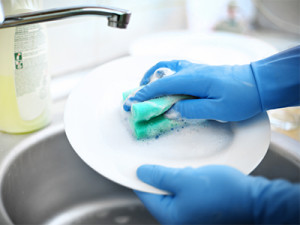Conservation
How can I save water in my home?

- Turn off the faucet when you brush your teeth can save 70 gallons or more per month.
- Take shorter showers. Reducing your shower time by just one minute can save as much as 75 gallons per month.
- Fix a leaky faucet with even a little drip—five drops per minute—can save more than 200 gallons of water per year.
- Replace your toilet or washing machine with a high-efficiency model. Rebates may be available.
- Install water-saving faucet aerators, high-efficiency shower heads, shutoff hose nozzles, and leak detection dye tablets. We have conservation kits available at no charge to our customers.
Customers who participated in our rebates and programs between 2016 and 2020 will help California save more than 9.2 billion gallons over the lifetimes of their new devices. That’s more than 148 billion cups!
How can I save water in my yard and garden?

It’s always been wise to conserve water in your home and garden. But in California today, conservation is more than just a good idea—it’s essential. We need to stretch our water supplies to insure that there is enough water to serve everyone who needs it.
One of the best places to make significant reductions in water use is in your garden. People who live in urban areas use about half of their water outdoors. In the summer, garden water use climbs even higher as the weather gets hotter and drier.
Fortunately, you can save water in your garden without sacrificing the quality of your landscaping. By taking advantage of efficient irrigation techniques and using ornamental plants and ground covers that are suitable to long, dry summers, you can enjoy a beautiful landscape that requires significantly less water and maintenance than a less carefully designed one.
Planting Hints
- Whenever possible, plant only low-water and drought-resistant plants. By using native plants—plants that are used to our climate—you may be able to reduce your outdoor water use significantly.
- Limit the amount of area devoted to your lawn. Lawns need great quantities of water, particularly in the summer.
- Wait until fall or winter to install a new garden. New plantings require more water than established growth.
- Consider planting low-water or drought-resistant plants.
- Keep low-water plants away from “thirsty” plants. Mediterranean-zone plants can suffer if they are over watered as you care for their neighbors.
- Place thirsty plants at the bottom of slopes, where they will benefit from water runoff.
- Keep shade plants in the shade. This will help prevent them from drying out.
- Include mulch around shrubs and plants to help reduce evaporation, limit weed growth, moderate soil temperature, and prevent erosion.
- Replace mulch around shrubs and plants at least once per year and remove weeds as needed.
Managing Your Lawn
- Limit the amount of area devoted to your lawn. Lawns need great quantities of water, particularly in the summer.
- A good way to check if your lawn needs watering is to just step on the grass. If it springs right back up, you don’t need to turn on the sprinklers. When it’s time to water, do it at dawn or dusk to reduce evaporation.
Watering Tips
- Mature trees require less water than newly planted ones.
- Check your sprinkler system regularly. A sprinkler system can waste water if sprinkler heads are broken, automatic timers are not adjusted for rain, or hidden leaks are not detected.
- Switch to a drip irrigation system for your yard.
More Outdoor Savings
- A garden hose can use 10 gallons of water per minute. Use a broom instead of a hose to clean patios, walkways, and driveways. When you do need the hose, use a nozzle to increase pressure and decrease water usage.
- Have a dirty car? Use a bucket of water instead of a hose to wash your car. Even better, take your car to a car wash that recycles its water.
Check the Rebates page for conservation rebates and programs that can help you maximize your outdoor water savings.
How can I save water in my pool?
- Use a pool cover to reduce water loss from evaporation.
- Repair pool leaks. A one-inch-per-day leak in a 15 foot by 30 foot pool can waste about 102,000 gallons per year.
- Manually clean your filter.
- Maintain proper chemical levels and adequate circulation time to avoid needing to either drain your pool or use excess water to correct issues.
- Consider turning off the tile-spray device on an automatic pool cleaner. This device can create splashing and overspray that ends up out of the pool or evaporates before it even hits the tile.
- Reevaluate the frequency of backwashing.
Source: California Urban Water Conservation Council
How can I save water in my apartment building?

Although apartments generally use less water than houses, in some ways apartment dwellers can do more to conserve water than homeowners. Think of it this way, if everyone in your building does a little something to save water, that small water savings is multiplied by the number of units. So if everyone saves just two gallons of water per day, your building may be saving 10, 50, or 100 gallons per day, depending on the number of units.
Some apartment dwellers pay their own water bills, and some do not. But whether or not you have an individual water bill, it benefits you to conserve water. Conservation helps keep water costs down, and water costs impact the price of necessities such as food (because farms use so much water)—and rent.
- Even if you already have a low-flow showerhead, every minute you shorten your shower can save up to 75 gallons per month. And remember, there’s power in numbers—if every apartment in a 15-unit building cut just one minute from their daily shower, that would be a savings of 1,125 gallons every month!
- Got a leaky faucet? Report leaks promptly to your building manager. A little drip may not seem like much, but a faucet that drips just five times per minute may be wasting more than 260 gallons per year.
- Do you leave the faucet running when you brush your teeth? Turn it off to save 70 gallons of water per month or more. You can also ask your building manager to install water-saving faucet aerators (available from Cal Water at no cost) to reduce your faucet water use even more.
- See a leaky sprinkler? An apartment building is a community, and what affects the building affects the tenants. If you see a leak—from a broken sprinkler, washing machine, or pipe, for example—report it immediately to your building manager.
- See room for improvement? Your building manager should also be notified if you see other types of water waste. For example, it’s best to water lawns when the sun is down to minimize evaporation, so you should inform your manager if an automated watering system’s timer seems to be off. You should also bring to your manager’s attention old, inefficient washing machines, gardeners who use water to clean walkways instead of sweeping them, and other sources of water waste.
How can I save water in my school?

As an education professional, you have a unique opportunity to promote water conservation in your community. You and every other person in your school are a resource—a potential ambassador for conservation. Here are a few suggestions for your school.
- Teachers: Because they interact directly with students, teachers can be effective cheerleaders for conservation. They can seek out water conservation-related projects and activities to keep students aware of conservation and help make it fun. They can also watch for students wasting water—by letting water fountains run or splashing water, for example—and correct the behavior.
- Maintenance Staff: Maintenance employees know the school’s infrastructure and are in the best position to spot problems. In addition to responding to complaints about water leaks, they can also proactively search for water waste. This is particularly important in the case of “invisible” leaks, such as those in irrigation systems.
- Students: Students, by virtue of their number, are the “worker bees” of school conservation. They should be encouraged to promptly report leaks and other instances of water waste, and to share what they learn about conservation with their families to help spread the conservation message throughout the community.
- Water Service Providers: Cal Water and other water service providers have programs and materials available to assist schools with conserving water and educating students about water conservation. Contact your local water service provider for more information on what programs and materials are available in your area.
How do I apply for a conservation rebate?
Go to the Rebates page and select your district to see what rebates are available to you.
Do I have to have an online account to get rebates?
An online account is not required to take advantage of our rebates. Many of our conservation programs and rebates do have an online application process for faster processing.
If you do not have access to a computer, you may contact your local Cal Water office for assistance applying for our conservation programs and rebates.
Do I have to install plants for the lawn-to-garden rebate?
Yes, in order to qualify for our lawn-to-garden rebate, at least 50 percent of the converted area must contain low-water-use, climate-appropriate, native, and non-invasive plants. Artificial turf does not qualify.
For more detailed information, please visit our Rebates page.
- 1
- 2

